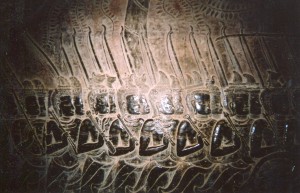Who are those dudes with the dreads? Are they an Angkor Wat hip hop group?
They’re actually part of a military procession, but they’re not normal Khmer troops. Their presence reveals a way that the king portrayed himself as the most important guy in the world. And they show how Khmers thought of other ethnic groups.
An inscription below them calls them Syam kuk. Some historians have thus inferred that they were Thais. But Thailand was largely populated by Mon people at that time–they spoke a language more closely related to Khmer than Thai. Thais migrated from southern China in larger numbers in the next century (the thirteenth). So who are these guys?
Vittorio Roveda thinks that they were mercenaries or allies from a nearby state that may or may not have been in Thailand. Whoever they were, they sure stood out from the Khmer troops.
We can note a couple of things about the Khmer soldiers:
1. Their behavior is composed and gentlemanly. The allies are hyper.
2. Their features are aristocratic. They’re both angular and elegant, like the court minister in yesterday’s post on Angkor Wat. They’re not realistic–they show a combination of power and noble refinement.
Angkor Wat’s sculptors were doing two things here:
1. They were showing that the king’s army is global–it includes all cultures. The diverse armies signify that everybody in the known universe joins the procession.
2. They showed these brave people as “the other”. They sharply distinguished them from the stately Khmer soldiers.
Angkor Wat portrays ethnic diversity, but it doesn’t show the variety of cultures in their own terms. Angkor Wat portrays them strictly as reflections of the king’s universal importance. The sculptors showed ethnic diversity as a sign of Suryavarman’s scope. Like Gothic cathedrals, Angkor Wat portrays a great deal of variety to illustrate a single system that its society was trying to impose on it. I found both magnificent, but I always felt a bit relieved when I left.
China during the Tang Dynasty also portrayed ethnic diversity in its own funky way.



Comments on this entry are closed.